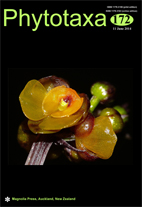Abstract
Melampyrum koreanum (Orobanchaceae) was described recently as an endemic species in Korea. This study examined the distribution range, relationship with the host plant, flower developmental pattern, pollinator, pollination mechanism, and seed development of M. koreanum (Orobanchaceae) on the island of Somaemul-do, Korea. M. koreanum is hemiparasitic and a strong candidate for its host plant is Pinus thunbergii, with which it is distributed sympatrically. The flower of M. koreanum represents a typical hawk moth pollination syndrome. Macroglossum pyrrhostictum Butler (Sphingidae, Lepidoptera), a diurnal hawk moth, is the only efficient pollinator. The proboscis length of M. pyrrhostictum and the floral tube length of M. koreanum are well coordinated, and the positions of the anther and stigma of M. koreanum are mechanically conformed to hawk moth pollination. The results suggest that adaptation to the pollinator is the main factor that has affected the evolution of the longer floral tube of M. koreanum compare to other species. Pollinator conservation in the native range of M. koreanum is an important issue for the conservation of endemic plant species, and it is necessary to establish a conservation plan for the host plant, Pinus thunbergii, as well as M. koreanum.

